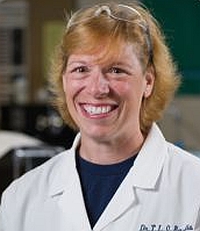Two presentations at the national meeting of the American Chemical Society in Philadelphia highlight new methods for combating counterfeit drugs, particularly in developing countries. Toni Barstis of Saint Mary’s College in Notre Dame, Indiana (pictured right) discussed a paper-strip test for Panadol, a pain killer based on acetaminophen, and Facundo Fernández at Georgia Tech in Atlanta developed a technology using mass spectrometry, a standard molecular analysis technique.
The World Health Organization defines a counterfeit medicine as “one which is deliberately and fraudulently mislabeled with respect to identity and/or source,” a definition applicable to both branded and generic drugs. The problem of counterfeit drugs, says WHO, is known to exist in both developed and developing countries, but most reports (60%) to WHO have come from developing countries.
Barstis’s group in St. Mary’s chemistry department developed a simple test for the authenticity of Panadol, a pain reliever containing acetaminophen, the ingredient in the popular over-the-counter drug Tylenol (The authors say no counterfeiting problem exists with Tylenol or other acetaminophen products marketed in the U.S.). “Panadol long has been among the most common, standard pain-relieving drugs counterfeited around the world,” says Barstis, a problem compounded by the ability of counterfeiters to print packaging almost exactly resembling the original.
Also compounding the problem is the long lead time — three to six months — needed to test counterfeit drugs in Europe or the U.S. In response, Barstis’s team developed a test using treated paper, with a strip about the size of a business card. By swiping the pill over the paper and dipping the strip in water, the tester can tell if the pills are fake by color changes on the paper. Barstis validated the test on 570 pills, including many with fake ingredients added by researchers. St. Mary’s College has applied for a patent for the test.
Fernández’s team at Georgia Tech likewise reduces the time needed to test for authenticity of drugs, in this case from a half-hour to just a few minutes. The researchers base their methods on mass spectrometry, a common lab technique that measures the weight and other properties of molecules.
A mass spectrometer converts molecules to ions, which enables them to be manipulated by external electric and magnetic fields. Fernández and colleagues used a more recent variation of the technique called ambient mass spectrometry that makes it possible to test samples in their original state, without special preparations.
“You can take a tablet, put it in front of the instrument with an ionization source,” says Fernández, “and you get a quick snapshot of what’s in the sample. It provides a very high-throughput pipeline to identify suspicious samples quickly.”
In a recent study, the Georgia Tech team identified several counterfeit anti-malarial medications among suspicious drugs from 11 African countries. The mass spectrometry technique can also distinguish between counterfeits and drugs that may have degraded after exposure to hot and humid conditions, as well as drugs where errors occur in the manufacturing process.
Read more:
- Award Funds Malaria Drug Anti-Counterfeiting Technology
- New Standards Released for Drug Impurity Limits, Methods
- Standards Proposed for Pharmaceutical Supply Chain Integrity
- Unregulated Drug Market Hurting TB Public Health Efforts
- Database to Track Substandard, Counterfeit Medicines
* * *


 RSS - Posts
RSS - Posts
[…] New Methods Developed to Combat Drug Counterfeiting […]
[…] New Methods Developed to Combat Drug Counterfeiting […]
The WHO(World Health Organization) has declared that at least 10 percent of the drug supply in developing countries consists of counterfeit medicines, causing thousands of deaths every year. Some countries such as Kenya, Nigeria, India, Vietnam and Panama. Many people dies due to using counterfeit antibiotics and anti-malaria medicines that do not contain the active ingredient to combat those diseases. Officials blame crime rings, which profit from selling at full-price pills that contain plaster of Paris, baking soda or other inexpensive ingredients. Testing of medicine take 3-6 months to test a batch of suspect drugs because the testing it is done in Europe or the U.S.
——————————————
blue lion bio
Thanks Charles for the additional details and your readership of Science Business. – AK